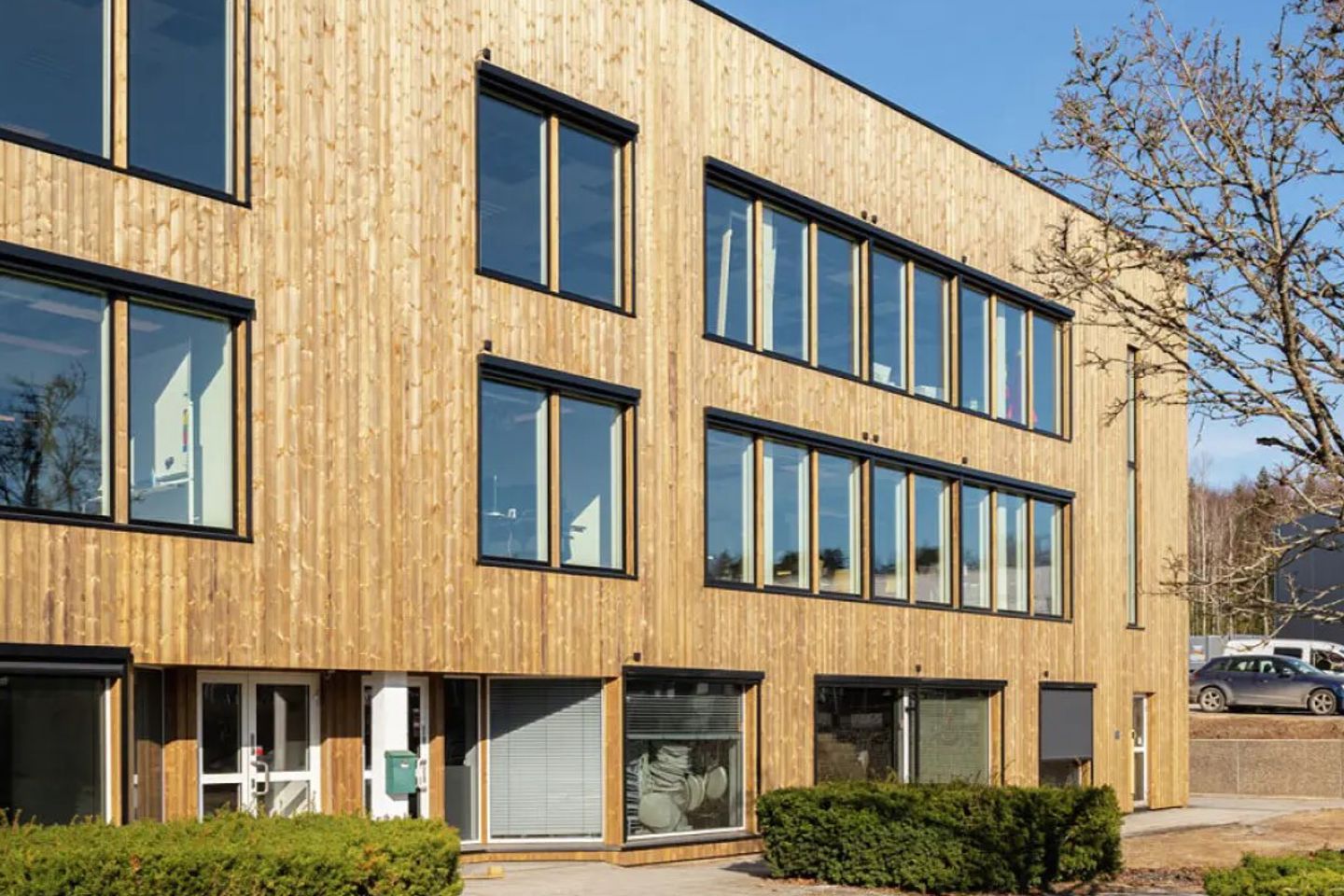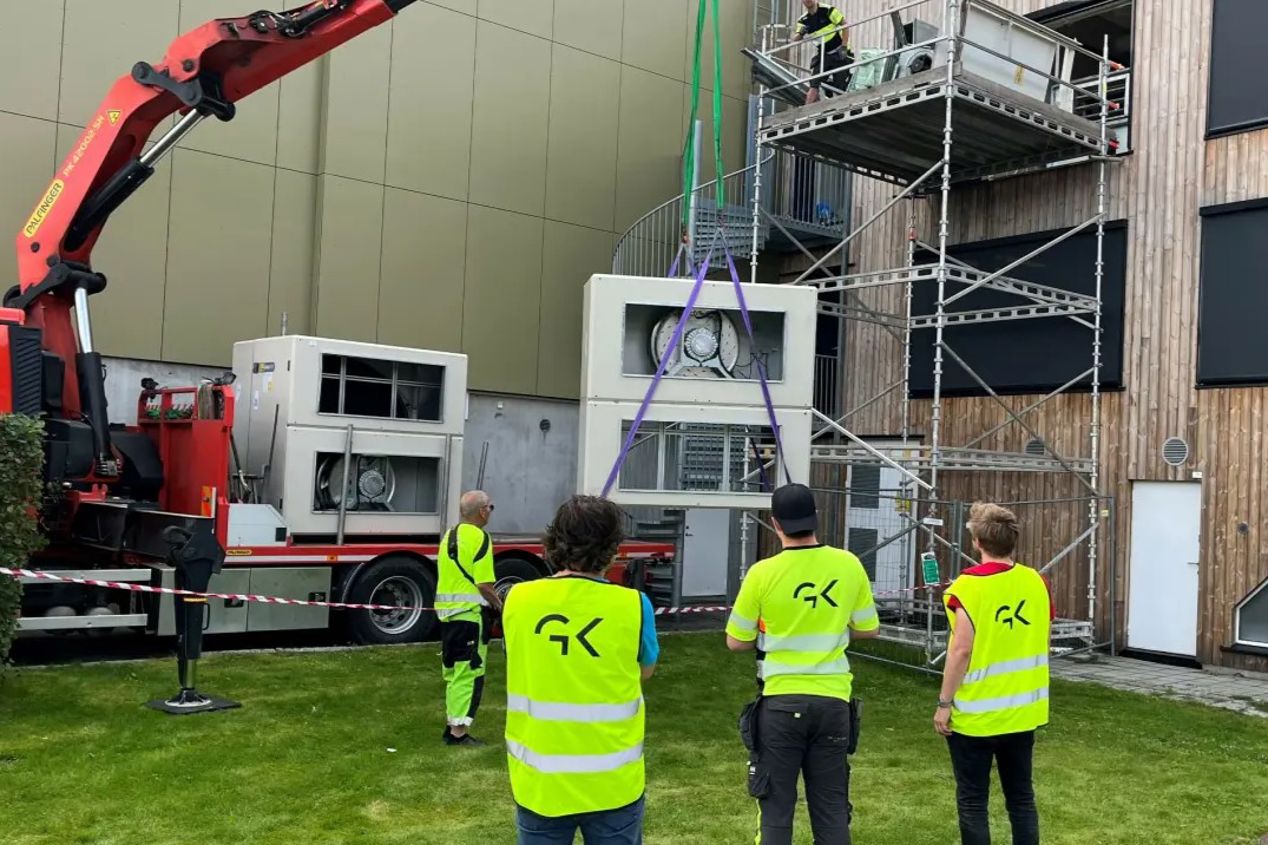How to get a recycling project going?
HVAC - The hidden climate giant

Glynitveien 33
Photo: Höegh Eiendom
We believe that part of the answer to this question lies in setting circular objectives for construction projects and systematizing the processes related to reuse in practice. In this article, we will share our experiences from working with reuse, based on a tenant adaptation in Glynitveien 33 (G33).
Goal of 100% reuse
Builders have a mandate and associated responsibility to put circularity on the agenda in construction projects. For the tenant adaptation in G33, Höegh Eiendom set high environmental ambitions from day one and a desire for 100% reuse.
Previous studies from the R&D project Green HVAC have shown that ventilation units are a significant contributor to greenhouse gas emissions from HVAC, largely due to the short expected lifetime (15-20 years) in the calculations. The short lifespan of units was therefore an "established truth" that we wanted to challenge, and the ambition to reuse a ventilation unit therefore became an important objective for the G33 project.
Request for quotation and contract form
Reuse must be set as a premise already in the request for quotation to give the contractor predictability of what is expected in the project and what they should price.
The cost picture at the start of a circular project is not as clear as for a traditional linear rehab or new construction project. Handling this uncertainty requires trust and good dialogue between the general contractor and the client. It is important to have good decision-making processes, risk assessments and a general desire from all parties to find circular and cost-effective solutions, which help to support the project's environmental ambitions and financial framework.
In the reuse project G33, it was chosen to go for an NS8407 general contracting contract with a target sum with Varden entrepreneur. Varden contractor brought a handful of good partners, including two partners in the Green Plumbing project; Multiconsult and GK.
The project owner took the risk
Risk analyses related to reuse were carried out continuously throughout the project. Materials and products with reduced lifespan due to previous use were given special time and assessments, e.g. reuse of ventilation units.
In the project, there was an agreement that it was the client, Höegh Eiendom, who assumed the risk by choosing reuse, thus waiving the warranty on the reuse products themselves. The general contractor and their suppliers were, however, still responsible for the design, execution and installation quality.
Systematization of the reuse process
In previous projects, we have experienced that the reuse process can be somewhat chaotic and that decisions have to be made on the spot that you may not have sufficient basis to make a decision on. In the G33 project, we therefore worked to systematize the material hunt and decision-making processes. We did this, among other things, by having the project group set up a timeline for when new products might need to be ordered to avoid delayed progress (if we could not obtain reusable materials), see Figure 1. These defined deadlines in combination with associated decision-making meetings contributed to prioritization in the material hunt and systematization of the reuse process.
Another measure to systematize the reuse process was to organize all reusable materials and make them available to the project group. We organized all interior and inventory on the reuse platform Loopfront. For the technical aspects, project managers from GK and Ing. F. Wickstrøm created their own material overviews in Excel and coordinated material capture and needs with the project group.
The material hunt
Varden contractor and their subcontractors were important drivers for finding circular solutions. The material hunt can be roughly divided into 3 steps, see Figure 2.

Illustrations of recycling process and material hunting Glynitveien 33
A lot of time was spent finding materials on the second-hand market. We used established second-hand portals (Ombygg, Finn.no, Tørn, Loopfront) and internal networks to find individual materials and donor buildings.
One challenge was that the materials we found had to be collected from many different locations; Oslo, Moss, Ski, Horten and Trondheim. Geographically dispersed material collection resulted in high costs for transport and logistics, as well as significant time spent managing the collection, transport and delivery of materials. The long-awaited, second-hand ventilation unit was found by GK in Trondheim; a quality unit of the Swegon Gold type that GK was to dismantle from a building owned by KLP (see Figure 3).
In addition, the second-hand market is still somewhat immature and less professionalized than the new goods market. Among other things, we experienced that some products we bought on the second-hand market had different dimensions or qualities and quantities than what was stated by the seller. This resulted in unforeseen adjustments and changes in the critical final phase of the project and additional costs associated with this. We have therefore learned that you must check the dimensions and qualities of recycled materials well in advance of installation to avoid time delays.

Photo: Viken foto og video_Hoegh Eiendom
High degree of reuse and satisfied customers
The project achieved a high proportion of reuse. The goal of 100% reuse was not fully met, due to a very tight schedule. However, of the total of 27.3 tons of materials added to the project, over 20 tons, or 74%, were either preserved materials from the project's own building, external reuse, surplus materials or recycled content in new materials, see Figure 4. This resulted in a greenhouse gas saving of approximately 40 kgCO2e/m2 from the production stage (A1-A3).
The premises have received a functional upgrade, good flow, rational zoning and high aesthetic quality, see Figure 3. Both the project owner and tenants are very satisfied with the final results.

Photo: Viken foto og video/Höegh Eiendom

Photo: Viken foto og video/Höegh Eiendom
Additional costs related to reuse - soon a thing of the past?
The materials in a reuse project are often low-priced, but entail a cost shift from material costs to execution, logistics and project management. Additional work related to transport, dismantling, reassembly, adaptations, etc. became an additional cost in the G33 project. Administration costs were also high for the same reason. Unpredictability regarding the quality and adaptations of solutions with reusable materials was also a factor that resulted in somewhat higher costs.
The additional cost for reuse in the project ended up being approximately 15% of the project's total costs. The project received support from Enova, which reduced the additional cost to approximately 10%.
A future extensive use of reuse centers or, ideally, that reusable items are an integrated part of the wholesalers' product flow, as well as a further maturation and professionalization of the reuse market will likely reduce or eliminate the additional costs related to reuse.
High degree of reuse is already possible today
To realize a high degree of reuse in construction projects today, it is essential to have clear goals and reuse ambitions and structured reuse processes. And most importantly; good cooperation and willingness from all parties to find circular solutions.
Whoever wants, can do it! High degree of reuse in construction projects is already possible today, also for technical systems.
Further information about Green HVAC
Green Plumbing is an Innovation Project in the business sector, supported by the Research Council of Norway. The project was carried out in the period September 2021 to March 2025.
Project objectives: Building competence, developing new services and sharing knowledge. Showing the way to a 50% reduction in greenhouse gas emissions from HVAC installations in model projects
The project manager is Multiconsult. Partners in the project are Höegh Eiendom, GK, Armaturjonsson, Swegon, KLP Eiendom and Pipelife. R&D supplier is OsloMet. The reference group consists of VKE and FutureBuilt.


